Forest Biome
Within the forest biome, we can recognize six major formations: low-latitude rainforest, monsoon forest, subtropical evergreen forest, midlatitude deciduous forest, needleleaf forest, and sclerophyll forest. Ecologists sometimes recognize three principal types of forest as separate biomes, based on their widespread nature and occurrence in different latitude belts: low-latitude rainforest, midlatitude deciduous and evergreen forest, and boreal forest.
LOW-LATITUDE RAINFOREST
Low-latitude rainforest, found in the equatorial and tropical latitude zones, consists of tall, closely spaced trees. Equatorial and tropical rainforests are not jungles of impenetrable plant thickets. Rather, the floor of the low-latitude rainforest is usually so densely shaded by a canopy of tree crowns that plant foliage is sparse close to the ground. The trees define a number of distinct rainforest layers (Figure 9.9).
Typical of the low-latitude rainforest are thick, woody lianas supported by the trunks and branches of trees. They climb to the upper canopy, where light is available, and develop numerous branches of their own.
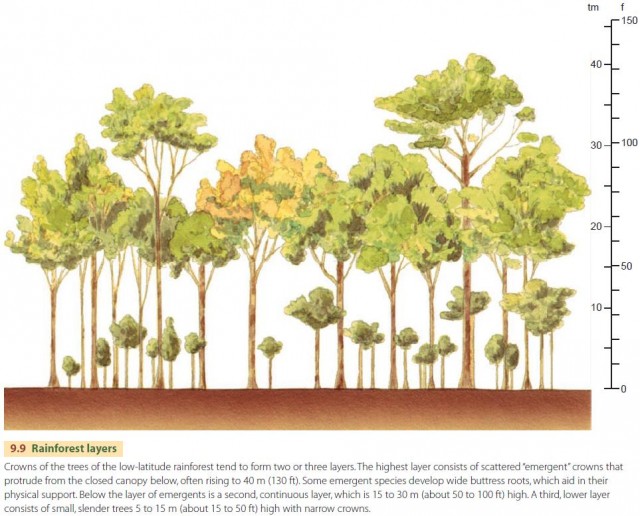
Epiphytes (“air plants”) are also common in low-latitude rainforest (Figure 9.8). These plants attach themselves to the trunk, branches, or foliage of trees and lianas. Their host is used solely as a means of physical support. Epiphytes include plants of many different types—ferns, orchids, mosses, and lichens.
Figure 9.10 shows the world distribution of lowlatitude rainforests. These rainforests develop in a climate that is continuously warm, frost-free, and has abundant precipitation in all months of the year (or, at most, has only one or two dry months). These conditions occur in the wet equatorial climate 1 and the monsoon and trade-wind coastal climate . Plants grow continuously throughout the year.
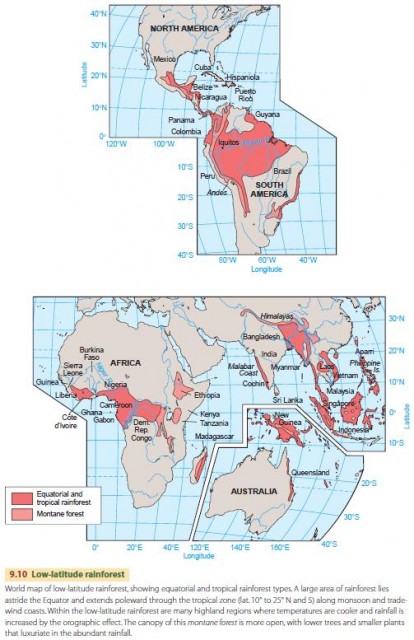
A particularly important characteristic of the lowlatitude rainforest is the large number of species of plants and animals that coexist. Equatorial rainforests contain as many as 3000 tree species within a few square kilometers.
Large herbivores are uncommon in the low-latitude rainforest. They include the African okapi and the tapir of South America and Asia. Most herbivores are climbers, and they include many primates—monkeys and apes. Tree sloths spend their lifetimes hanging upside down as they browse the forest canopy. There are only a few large predators. Notable are the leopards of African and Asian forests and the jaguars and ocelots of the South American forests.
MONSOON FOREST
Figure 9.11 is a world map of the monsoon forest. It is typically open, but grades into woodland, with open areas occupied by shrubs and grasses. Monsoon forest of the tropical latitude zone differs from tropical rainforest because it is deciduous; that is, most of the trees of the monsoon forest shed their leaves because of stress during the long dry season that occurs at the time of low sun and cool temperatures.
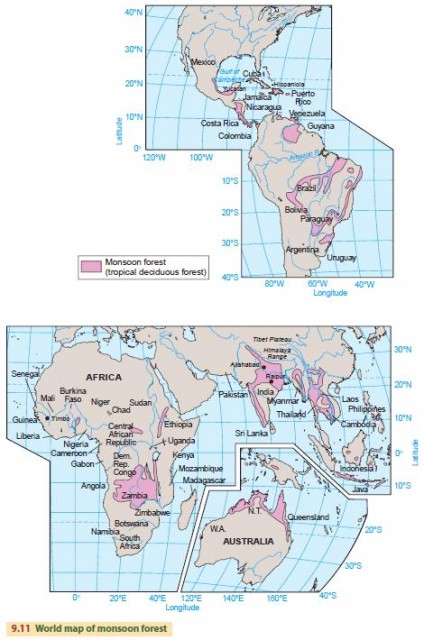
This forest develops in the wet-dry tropical climate , where a long rainy season alternates with a dry, rather cool season. The typical regions of monsoon forest are in Myanmar, Thailand, and Cambodia. In the monsoon forest of southern Asia, the teakwood tree was once abundant and was widely exported to the Western world to make furniture, paneling, and decking. Now this great tree is logged out. Large areas of monsoon forest also occur in south-central Africa and in Central and South America, bordering the equatorial and tropical rainforests.
SUBTROPICAL EVERGREEN FOREST
Subtropical evergreen forest is generally found in regions of moist subtropical climate, where winters are mild and there is ample rainfall throughout the year (Figure 9.13). This forest occurs in two forms: broadleaf and needleleaf (Figure 9.14).
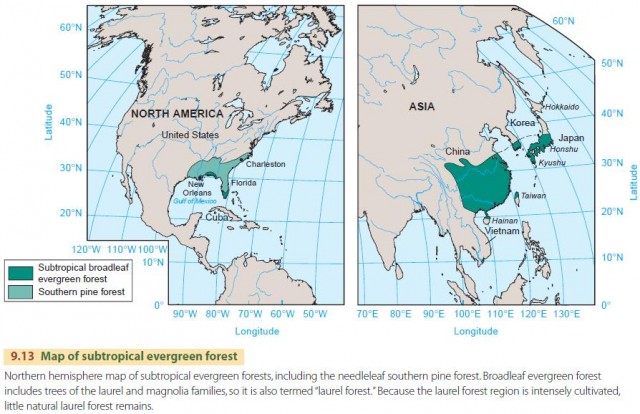
The subtropical broadleaf evergreen forest has fewer tree species than the low-latitude rainforests, which are also broadleaf evergreen types. Trees are also not as tall as in the low-latitude rainforests. Their leaves tend to be smaller and more leathery, and the leaf canopy is less dense. The subtropical broadleaf evergreen forest often has a welldeveloped lower layer of vegetation. Depending on the location, this layer may include tree ferns, small palms, bamboos, shrubs, and herbaceous plants. There are also many lianas and epiphytes. The subtropical broadleaf evergreen forest is associated with the moist subtropical climate in the southeastern United States, southern China, and southern Japan. In these areas, the land has been cleared of natural vegetation and replaced by agriculture for centuries.
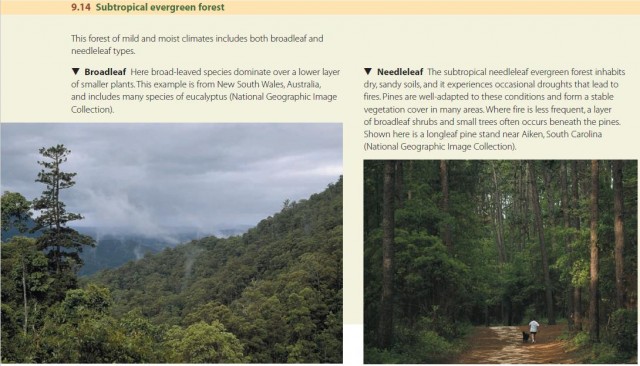
Figure 9.14 shows the subtropical evergreen forests of the northern hemisphere. The subtropical needleleaf evergreen forest occurs only in the southeastern United States. Here it is referred to as the southern pine forest, since it is dominated by species of pine. Much of this area is now in commercial pine plantations that produce lumber, kraft paper, cardboard, and related wood products.
MIDLATITUDE DECIDUOUS FOREST
Midlatitude deciduous forest is the native forest type of eastern North America and western Europe. It is dominated by tall, broadleaf trees that provide a continuous and dense canopy in summer but shed their leaves completely in the winter. Lower layers of small trees and shrubs are weakly developed. In the spring, a lush layer of low herbs quickly develops but soon fades after the trees reach full foliage and shade the ground. The deciduous forest includes a great variety of animal life, stratified according to canopy layers.
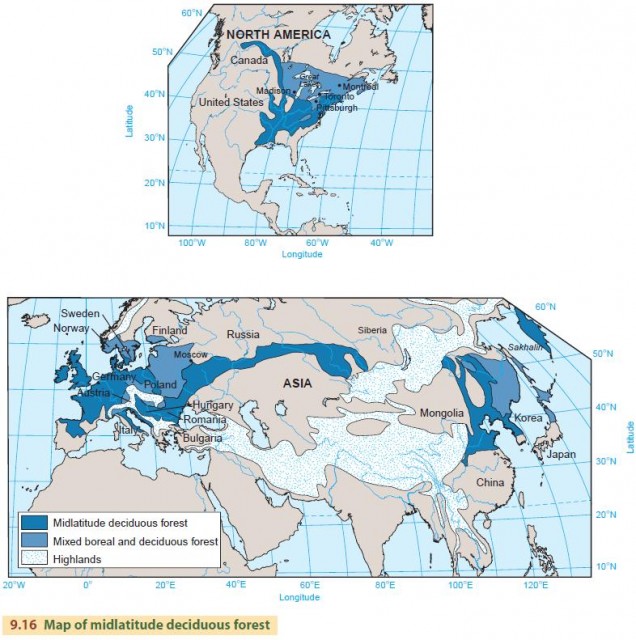
Figure 9.16 is a map of midlatitude deciduous forests, which are found almost entirely in the northern hemisphere. This forest type is associated with the moist continental climate, which receives adequate precipitation in all months, normally with a summer maximum. There is a strong annual temperature cycle with a cold winter season and a warm summer.
Common trees of the deciduous forest of eastern North America, southeastern Europe, and eastern Asia are oak, beech, birch, hickory, walnut, maple, elm, and ash. Where the deciduous forests have been cleared by lumbering, pines readily develop as secondgrowth forest.
In western Europe, the midlatitude deciduous forest is associated with the marine west-coast climat. Here the dominant trees are mostly oak and ash, with beech in cooler and moister areas. In Asia, the midlatitude deciduous forest occurs as a belt between the boreal forest to the north and steppelands to the south. A small area of deciduous forest is found in Patagonia, near the southern tip of South America.
NEEDLELEAF FOREST
Needleleaf forest is composed largely of conifers—straighttrunked, cone-shaped trees with relatively short branches and small, narrow, needle-like leaves. Most conifers are evergreen, retaining their needles for several years before shedding them. At any location, species are usually few in number. In fact, large tracts of needleleaf forest consist almost entirely of only one or two species. When the needleleaf forest is dense, it provides continuous and deep shade to the ground. Lower layers of vegetation are sparse or absent, except for possibly a thick carpet of mosses.
Boreal forest is the cold-climate needleleaf forest of high latitudes. It occurs in two great continental belts, one in North America and one in Eurasia (Figure 9.18). These belts span their land masses from west to east in latitudes 45° N to 75° N, and they closely correspond to the region of boreal forest climate .
The boreal forest of North America, Europe, and western Siberia is composed of such evergreen conifers as spruce and fir, while the boreal forest of northcentral and eastern Siberia is dominated by larch. The larch tree sheds its needles in winter and is thus a deciduous needleleaf tree. Broadleaf deciduous trees, such as aspen, balsam poplar, willow, and birch, tend to take over rapidly in areas of needleleaf forest that have been burned over. These species can also be found bordering streams and in open places. Between the boreal forest and the midlatitude deciduous forest lies a broad transition zone of mixed boreal and deciduous forest.
Coastal forest is a distinctive needleleaf evergreen forest of the Pacific Northwest coastal belt, ranging in latitude from northern California to southern Alaska. Here, in a band of heavy orographic precipitation, mild temperatures, and high humidity, are perhaps the densest of all conifer forests, with magnificent specimens of cedar, spruce, and Douglas fir. At the extreme southern end, coastal forest includes the world's largest trees—redwoods (Figure 9.19). Individual redwood trees attain heights of over 115 m (377 ft) and diameters of over 7 m (23 ft) at the base.
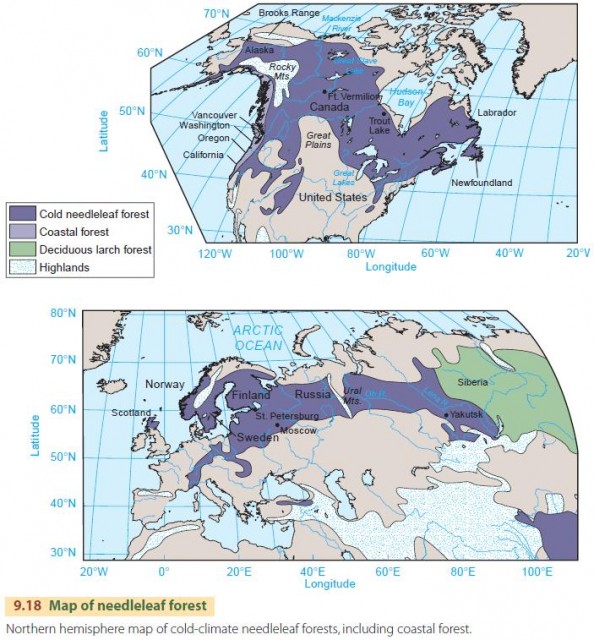
SCLEROPHYLL FOREST
The native vegetation of the Mediterranean climate is adapted to survival through the long summer drought. Shrubs and trees that can survive such drought are equipped with small, hard, or thick leaves that resist water loss through transpiration. These plants are called sclerophylls.
Sclerophyll forest is made up of trees with small, hard, leathery leaves. The trees are often low-branched and gnarled, with thick bark. The formation class includes sclerophyll woodland, an open forest in which only 25 to 60 percent of the ground is covered by trees. Also included are extensive areas of scrub, a plant formation type consisting of shrubs covering somewhat less than half of the ground area. The trees and shrubs are evergreen, retaining their thickened leaves despite a severe annual drought. Our map
of sclerophyll vegetation, Figure 9.20, includes forest, woodland, and scrub types. Sclerophyll forest is limited to west coasts between 30° and 40°–45° N and S latitude. In the California coastal ranges, the sclerophyll forest or woodland is typically dominated by live oak and white oak.
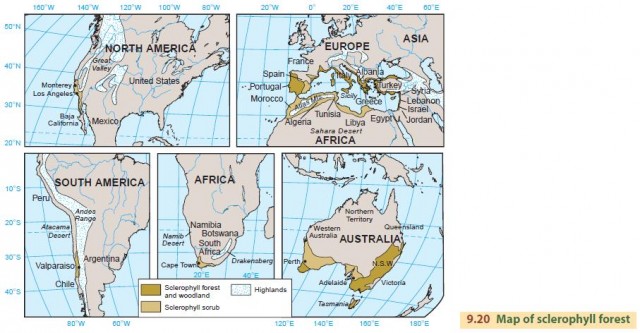
Grassland occupies the open ground between the scattered oaks. Much of the remaining vegetation is sclerophyll scrub known as chaparral. In the Mediterranean lands, the sclerophyll forest forms a narrow coastal belt ringing the Mediterranean Sea. Here, the Mediterranean forest consists of such trees as cork oak, live oak, Aleppo pine, stone pine, and olive. Important areas of sclerophyll forest, woodland, and scrub are found in southeast, south-central, and southwest Australia, Chile, and the Cape region of South Africa.
Over the centuries, human activity has reduced the sclerophyll forest to woodland or destroyed it entirely. Today, large areas of this former forest consist of dense scrub.